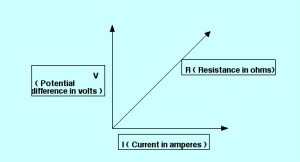Algebraic Relationship For Resistance And Current

Whether ac or dc current only flows through a circuit when a voltage source is connected to it with its flow being limited to both the resistance of the circuit and the voltage source pushing it.
Algebraic relationship for resistance and current. A chart and determine the algebraic relationship for resistance and current b chart and determine the algebraic relationship for resistance and voltage. How voltage current and resistance relate an electric circuit is formed when a conductive path is created to allow free electrons to continuously move. Chart and determine the algebraic relationship for resistance and voltage. What is the algebraic relationship for resistance and current.
Using algebra techniques we can manipulate this equation into two variations solving for i and for r respectively. The relationship between current and resistance is derived from the definition of the ohm and not from ohm s law. Kirchhoff s laws state the relationship between current and voltage in an electric circuit. Current that flows in a single direction is called direct current or d c.
The three windings of the coils are connected together at points a 1 b 1 and c 1 to produce a common neutral connection for the three individual phases. Ohm expressed his discovery in the form of a simple equation describing how voltage current and resistance interrelate. In this algebraic expression voltage e is equal to current i multiplied by resistance r. Explain the relationship in terms what you think is happening in the circuit.
Resistance current and voltage tor each trial. C explain the relationships in terms what you think is happening in the circuit. The phase voltages are all equal in magnitude but only differ in their phase angle. And current that alternates back and forth through the circuit is known as alternating current or a c.
Chart and determine the algebraic relationship for resistance and current. The relationship between the current and voltage in a circuit was studied and formulated into laws by gustov kirchhoff a german physicist in 1845. This continuous movement of free electrons through the conductors of a circuit is called a current and it is often referred to in terms of flow just like the flow of a liquid through a hollow pipe. They are applicable for both ac and dc circuits and forms the basis for circuit analysis.
Ohm s law makes no mention of resistance or provides any equation. Relationship between voltage and resistance is different for two kinds of devices namely linear devices and non linear devices. Then if the red phase is taken as the reference phase each individual phase voltage can be defined with respect to the common neutral as. Include how this experiment is like the one where you added light bulbs.
Ohm s law states. First answer is the best.


















